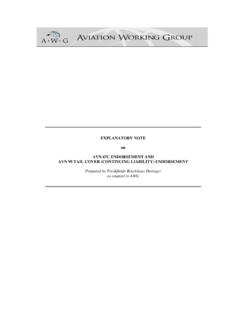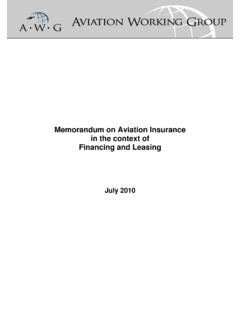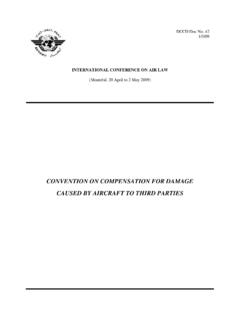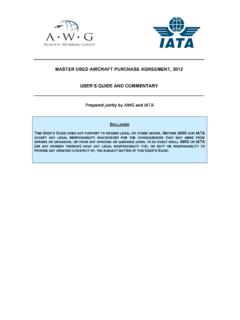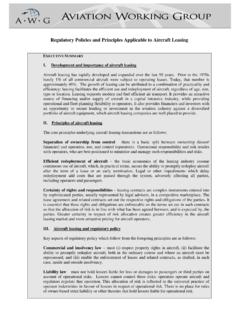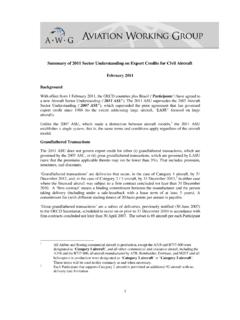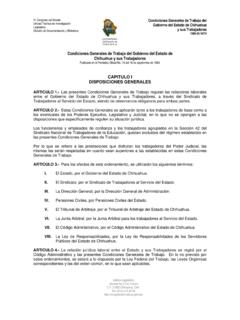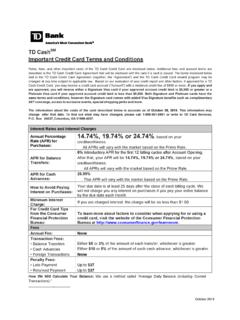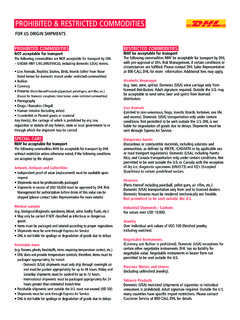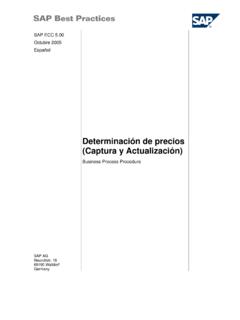Transcription of Analysis of Impact of Aircraft Age on Safety-Draft 11
1 Analysis of Impact of Aircraft Age on safety for Air Transport Jet Airplanes Professor R. John Hansman October 2014. MIT International Center for Air Transportation (ICAT). Department of Aeronautics & Astronautics Massachusetts Institute of Technology Cambridge, MA 02139 USA. 1. Analysis of Impact of Aircraft Age on safety for Air Transport Jet Airplanes Professor R. John Hansman MIT International Center for Air Transportation Executive Summary A historical Analysis was conducted of Aircraft accidents occurring between 1959. and 2012 for commercial jet transport Aircraft with a MTOW greater that 60,000. lbs where Aircraft age and operational histories were available.
2 The Analysis indicates that there is no correlation between the fatal accident rates and Aircraft age up to 27 years of age. Above this age there was a slight increase in the fatal accident rate but the accident rate data is not statistically significant due to the limited number of operational years for these older Aircraft cohorts. When all accidents are considered there is no correlation between accident rates and age up till 18 years and a weak trend of increased accident rate with age is observed for Aircraft older than 20 years. This increase in the worldwide accident rate is driven mainly by Africa which exhibits a statistically significant increase in accident rate for Aircraft older than 20 years.
3 Other regions such as North America and Europe do not exhibit any correlation of accident rate with Aircraft age. An Analysis of the accidents in which the Aircraft were older than 20 years of age indicates that that the observed increase in accident rate in Africa is not due to aging Aircraft factors but due to other risk factors. The Analysis does not support age-based import restrictions as an effective measure to increase aviation safety , providing Design Approval Holders and Type Certification Authorities support National Aviation Authorities in managing older fleets under their responsibility. 1. Background Modern commercial air transport jet Aircraft are significant economic assets that can have an effective economic useful life of decades.
4 For the past two decades, the average age of the worldwide air transport jet fleet has been between 10 and 12 years old. However, the size of the fleet has grown substantially so that the population of airplanes with ages in excess of 20 years has continued to increase. Concerns regarding the safety of aging air transport jet Aircraft , due to corrosion, fatigue or Widespread Fatigue Damage (WFD) rose following the dramatic in- flight explosive decompression of Aloha Airlines Flight 243 in 1988. The pressurization vessel of the 19-year old, heavily-used Boeing 737-297 was compromised and one occupant was ejected. The Aircraft was, however, able to 2.
5 Land. At the time of the accident, the Aircraft had 35,486 hours of flight time and 89,680 flight cycles. The number of flight cycles was unusually high due to the short stage lengths that Aloha Airlines flew in In the aftermath of this accident, a number of actions were taken to monitor and assure the airworthiness of older air transport Aircraft . In the United States, the Federal Aviation Administration (FAA) initiated a major research program on aging Aircraft . The Airworthiness Assurance Working Group (AAWG) which consists of international manufacturers, operators, maintenance organizations and regulatory groups, was formed to find ways to address ageing issues such as corrosion and WFD that were found in the Aloha accident and in other incidents with older ,3,4,5.
6 The areas of concern regarding ageing Aircraft were expanded to include Aircraft systems such as wiring systems in 1996 following the in-flight breakup a 25 year old Boeing 747 operated as TWA Flight After this accident, at the recommendation of the White House Commission on Aviation safety and Security (WHCSS), the FAA expanded its Aging Aircraft Program, which focused on structures, to cover non-structural systems. The FAA developed the Aging Transport Nonstructural Systems Plan. While the plan's primary focus was on electrical wiring systems, there are other on-going research and development activities that address mechanical and avionics systems7.
7 One of the key questions regarding aging Aircraft was whether chronological age or operational exposure ( flight cycles or flight hours) were the factors which created age-related risk such as corrosion or Widespread Fatigue Damage for the Aircraft . The AAWG and the FAA ultimately concluded that chronological age was a better indicator of environmental damage, while operational exposure was a better indicator of fatigue damage, including WFD. Airworthiness could be assured with proper maintenance and identification of specific operational Limits of Validity (LOV) for Aircraft structures where failure is potentially catastrophic.
8 Once the LOV limits were reached the Aircraft could remain airworthy if specific inspections, modifications or replacements were performed. Depending on the particular component and the fatigue mechanism, the LOV. could be defined in flight cycles or flight hours. In 2011 the FAA issued a number 1 NTSB Accident Report Aloha Airlines, Flight 243 Boeing 737-200, N73711, Near Maui, Hawaii 2 National Aging Aircraft Research Program, DOT/FAA/CT-88/32-1, September 1991, Federal Register Volume 66, Number 56, March 22, 2001. 3 Federal Register Volume 66, Number 56, March 22, 2001. 4 How Old is too Old? The Impact of Ageing Aircraft on Aviation safety , Australian Transportation safety Board Transport safety Report B20050205, February 2007.
9 5 6 NTSB Aircraft Accident Report, In-flight Breakup Over the Atlantic Ocean Trans World Airlines Flight 800, Boeing 747-131, N93119, Near East Moriches, New York, July 17, 1996 (PB2000- 910403, NTSB/AAR-00/03, DCA96MA070) 7 Enhanced Airworthiness Program for Airplane Systems/Fuel Tank safety (EAPAS/FTS). #page=1. 3. of regulatory amendments implementing WFD rules and the LOV approach. Similar rules are under development by EASA in Europe and are anticipated to be adopted by many other regulatory agencies around the In the early 1990's, regulatory agencies (including the FAA) required that operators of air transport jet Aircraft incorporate an approved Corrosion Prevention and Control Program (CPCP) into their maintenance program9.
10 Some states took alternative approaches to managing the exposure risk of aging Aircraft by imposing both conventional maintenance requirements and chronological age limits under the assumption that newer Aircraft were safer than older Aircraft . In general, these limits were imposed on Aircraft importation, and vary from 10 to 25 The wide variation in limits indicates that such age- based import restrictions do not necessarily have a specific technical basis. If chronological age is not a valid indicator of increased safety risk, then imposing conservative age based import restrictions reduce the population of available air transport Aircraft and thereby increase the cost and reduce the access to air transportation for those states that impose such restrictions.
